Andrew Romero1, Daniel Lynch1*, Evan Johnson2, Tammy Phillips3, Daniel Topping4, John Kirkpatrick5, Francisco Schwartz-Fernandes6
1University of Central Florida/HCA Healthcare GME Consortium, Ocala, FL, USA
2University of Tennessee-Campbell Clinic, Memphis, TN, USA
3University of Central Florida College of Medicine, Orlando, FL, USA
4University of Florida College of Medicine, Gainesville, FL, USA
5Orlando VA Medical Center, Orlando, FL, USA
6Advent Health, Ocala, FL, USA
*Correspondence author: Daniel Lynch, MD, University of Tennessee-Campbell Clinic, Memphis, TN, USA;
Email: [email protected]
Published Date: 08-11-2024
Copyright© 2024 by Romero A, et al. All rights reserved. This is an open access article distributed under the terms of the Creative Commons Attribution License, which permits unrestricted use, distribution, and reproduction in any medium, provided the original author and source are credited.
Abstract
Objectives: To investigate the effectiveness and reliability of 3-Dimensional (3D) printed models of the contralateral, unaffected clavicle to serve as templates of the affected side for preoperative planning.
Method: Computed tomography scans of 18 embalmed cadavers (8 male and 10 female) were used to 3D-print mirror images of “unaffected” clavicles which were then used for the selection of a superior midshaft contoured plate. Various morphometric and goodness-of-fit measurements were taken of the 3D-printed clavicle and then the in-situ specimen. Statistical analysis was performed using two-tailed, unpaired t-tests with a p value < 0.05.
Results: For 3D-printed models, 7/9 morphometric measurements differed significantly between males and females for both clavicles and in 1 additional measurement for right-sided clavicles. For in-situ specimens, 6/9 morphometric measurements differed significantly between male and female clavicles. When comparing the 3D-printed versus the corresponding in-situ clavicle, only 1/9 morphometric measurements differed significantly for both males and females and 1 additional measurement for each sex. The goodness-of-fit of the plate using the 3D-printed template for the in-situ specimen differed significantly only for males with a right clavicle mirrored to template for the left clavicle.
Conclusions: Clavicular anatomic complexity and variance supports the need for many contoured plate options for adequate fixation. Preoperatively 3D-printed contralateral, mirrored clavicles for plate selection of midshaft clavicular fractures may reduce intraoperative time.
Keywords: Clavicle; 3D-Printing; Orthopaedic Trauma; Cadaver Model
Level of Evidence: Level V, Therapeutic
Introduction
Clavicular fractures are a common orthopaedic injury, making up 5-10% of all fractures [1-5]. The majority of fractures are midshaft (80%), followed by lateral third (10-18%) and medial third (2-10%) [1,6-8]. Recently, the incidence of operative treatment for clavicular fractures has increased, as it provides strong fixation for early rehabilitation [9,10]. Some indications for operative fixation include related neurovascular compromise, open fractures, skin tenting, severe angulation, 100% displacement, shortening greater than 2 cm and floating shoulder injury [1].
Research has shown a strong correlation between ipsilateral clavicle fractures, especially with shortening and the development of glenohumeral joint arthritis.5 Significant shortening has been associated with worse outcomes, higher incidence of pain, functional deficit and poor cosmesis when treated nonoperatively [11]. There has been investigation into the normal variation in length, cross-sectional morphology, medial and lateral angles and bow in the transverse plane of the clavicle to assist with plate design [8]. Studies have also shed light onto the variation between male and female clavicles as well as between the left and right clavicle in an individual, with the left clavicle tending to be longer and the right thicker; this is hypothesized to be secondary to handedness and clavicular loading [7,11-14]. Variations in mechanical forces, asymmetric vascularization, activity-induced changes and favored loading secondary to handedness are all factors responsible for the asymmetry of various clavicular features [15,16].
The use of 3-Dimensional (3D) printing technology is becoming more common in product design industries, especially in the field of medicine [17-24]. This technology is currently used to create anatomic models for surgical planning and intraoperative navigation, to trial medical device prototypes prior to production and to build patient-specific surgical instruments [24-28]. However, there remains limited data on the accuracy of 3D-printed bony specimens with direct comparison measurements made on cadaveric specimens [11,15,29]. The purpose of this study was to determine not only the effectiveness but the reliability of 3D-printed clavicular models to serve as templates for preoperative planning and contouring of plates with cadaveric verification [30]. It is our vision that the findings of this study can pave the way for more complex bony models for other traumatic orthopaedic injuries.
Material and Methods
Computed Tomography (CT) scans of 18 embalmed cadavers (8 male and 10 female) were used to render the mirror image of the contralateral clavicle for 3D printing with Materialise Mimics Research 19.0 3D medical imaging processing software and Materialise 3-Matic Research 11.0 64-bit 3D modeling software (Materialise, Leuven, Belgium) (Fig. 1). The models were then printed using standard Polylactic Acid (PLA) filament with a MakerBot Replicator+ 3D printer (MakerBot Industries, Brooklyn, NY) to serve as templates for the selection of superior midshaft precontoured Styker VariAx system plates (Stryker, Kalamazoo, MI) (Fig. 2). The precontoured plates were further contoured to fit the 3D-printed model and then applied to the corresponding in-situ specimen (Fig. 3). Both left for right and right for left clavicular models were made, but only one iteration per cadaver. The models could be digitally produced within 20 minutes and utilized less than a dollar of material.
Comparisons were made both between male and female clavicles for both types of specimens and between the 3D-printed models and their corresponding in-situ clavicles. Various morphometric measurements established by Sehrawat, et al., were recorded (Table 1 and Fig. 4) [15]. Goodness-of-fit of the plate on the clavicular specimens was measured using the Clavicle Congruence Score (CCS) established by Malhas, et al., [7]. A score of 3 (anatomic) signified perfect congruence, with a gap < 1 mm and no plate overhang. A score of 2 (good) signified a gap > 1 mm, every plate hole over bone, either anterior or posterior overhang present and contouring of < 30 degrees being required. A score of 1 (poor) signified complete mismatch with at least 1 plate hole not over bone, either anterior or posterior overhang present and contouring of > 30 degrees being required. Other plating measurements recorded included Sternal Distance (SD), the distance from the sternal end to the medial end of the plate; Acromial Distance (AD), the distance from the acromial end to the lateral end of the plate; Acromial Shaft Height with Plate (ASHP); Sternal Shaft Height with Plate (SSHP) and Midshaft Height with Plate (MSHP). Two-tailed, unpaired t-tests were used to look for statistically significant differences between the measurements.
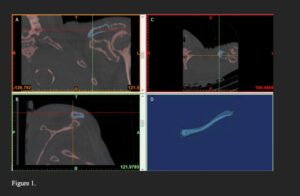
Figure 1: Coronal (A), sagittal (B) and axial (C) views demonstrating the isolation of a left clavicle (D) with Materialise Mimics Research 19.0 3D medical imaging processing software.
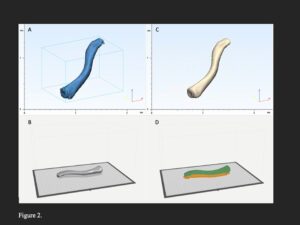
Figure 2: Using exported image file from Materialise Mimics Research 19.0 to Materialise 3-Matic Research 11.0 64-bit 3D modeling software (A) to smooth out rough edges yields a final printable image (B). The image is then exported to MakerBot Print (B), where the software automatically applies support structure (D) easily contrastable from the final printed product. The support structure easily breaks free from the print after printing.
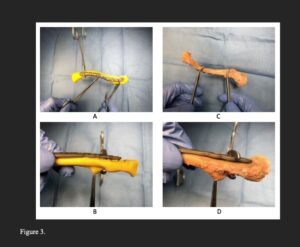
Figure 3: Example of 3D-printed mirror image of the right clavicle (A,B) serving as a template for plate selection for the left-sided cadaveric clavicle (C,D).
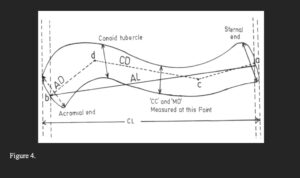
Figure 4: Depiction of morphometric measurements used adopted from Sehrawat, et al., [15].
Results
Morphometric Comparisons
Morphometric comparison results between male and female for 3D-printed versus in-situ clavicle specimens are displayed in Table 2. For the 3D-printed specimens, significant differences were found between male and female clavicles for CL, AL, CC, SD, AD, MD, CD and right-sided MA. For in-situ clavicles, significant differences were found between male and female clavicles for CL, AL, CC, SD, AD and MD. When directly comparing the 3D-printed and in-situ clavicles, there were significant differences between left-sided CC in both male and female clavicles, right-sided AD in female clavicles and left-sided MA in male clavicles.
Plating Comparisons
Clavicular plating comparison results between male and female for 3D-printed versus in-situ clavicle specimens are displayed in Table 3. For both the 3D-printed and in-situ clavicles, no significant differences in CCS in either male or female clavicles were found. For 3D-printed clavicles, significant differences were found between male and female clavicular right-sided SSHP and both right and left-sided MSHP. For in-situ clavicles, significant differences were found between male and female clavicular left-sided SSHP and both right and left-sided MSHP. When directly comparing the 3D-printed and in-situ clavicles, the CCS differed significantly only for males with a right clavicle mirrored to template the left clavicle. In addition, significant differences were found for right-sided MSHP in males and females and in left-sided MSHP for females.
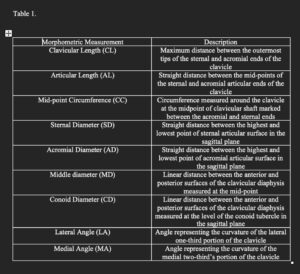
Table 1: Definitions of morphometric measurements used adopted from Sehrawat, et al., [15].

Table 2: Morphometric measurement differences between male and female or 3D-printed and in-situ clavicle specimens.

Table 3: Plating measurement differences between male and female or 3D-printed and in-situ clavicle specimens.
Discussion
Previous cadaveric study has investigated how appropriately superior midshaft clavicle plate systems contour to the human clavicle [7]. A study by Kim, et al., demonstrated that 3D-printed clavicle model templates were effective for fixation of seven comminuted midshaft clavicle fractures [17]. Our results further expand upon the utility of this technique by demonstrating the variability between male and female clavicles and between left and right clavicles using various measurements. Our goal was to demonstrate that, despite the variable clavicular anatomy between people, the technique of using the contralateral intact clavicle when templating for the clavicle fracture yields a model with very similar dimensions as the in-situ clavicle to be fixed. We demonstrated that using this model allows accurate plate fit and placement on the clavicle of interest.
In the present study, there were many significant morphometric measurement differences found between male and female clavicles and between left and right clavicles on average. However, when comparing the 3D-printed clavicles and their corresponding contralateral in-situ clavicles, there were no significant differences when it came to morphometric, goodness-of-fit and plate-bone dimension measurements in the majority of cases. In other words, the numerous morphometric measurements that differed significantly had little impact on the actual plate goodness-of-fit, except for men who had a left clavicle template made from the right clavicle. A possible explanation is that longer clavicles typically have broader plating options while maintaining acceptable goodness-of-fit and right sided clavicles tend to be shorter and thicker [7].
For clavicles, picking the appropriate plate can affect the cosmetic acceptability and clinical outcomes, including the need for future hardware removal [31,32]. Today, precontoured implants are manufactured to fit many bones in the body, but they are not always useful or appropriate for bones with as much variable anatomy as the clavicle or bones with large zones of comminution, for which the process described by this study may prove to be more useful [33]. This is important, as plate position and fit, if not close to anatomic in fracture reduction, can malreduce fractures and lead to an array of postsurgical complications.
Normally, the complexity and variability in the anatomy of the clavicle necessitates the need for many plating options intraoperatively. In the present study, it was found that 3D-printing a clavicular template before clavicular fracture fixation may be a viable and timely method to both reduce operating room time and reduce the number of surgical trays required intraoperatively by allowing the surgeon to start the procedure with a well-fitting plate already available. A printable digital clavicular model took one of our researchers approximately 20 minutes to produce from CT scans, which can then be printed. Print jobs are done completely by the 3-D printers and take approximately 45 minutes to an hour to complete. It is postulated that a single trained technician can produce similar printable digital imaging from CT scans in less time. Once a surgeon preoperatively uses the model to select and contour a plate, the plate can then be autoclaved for surgery, saving valuable intraoperative time and reducing patient risk profiles from surgery. This method of utilizing a template for fixation purposes could also aid in the preoperative planning of bridge plating comminuted fractures where length, alignment and rotation are more difficult to assess.
Research in the field of 3D-printing to create anatomic models for orthopaedic fixation has been expanding rapidly [34,35]. Though limited, analysis of the utility of 3D virtual surgical planning with 3D-printing has been explored with injuries to the upper extremity and to complicated injuries of the ankle joint [30,36-38]. Future studies should continue to investigate the utility, feasibility and cost effectiveness of 3D-printing. There exists some research analyzing the use of 3D-printing for more complicated fractures of the pelvis and acetabulum [30,39-41]. However, mainstream utility of such methods backed by sufficient evidence remains to be seen. Future studies should also take our results a step further and measure the operative parameters such as cost and operative time to treat clavicle fractures with and without preoperative plate selection.
Our study had limitations intrinsic to most cadaveric studies. Our sample size was small, resulting in the possibility that the clavicles may differ from the general population. Our sample size may also not represent the full spectrum of variations encountered in the clavicle. Another limitation is that the handedness of the specimens was not known and the effect of handedness has been shown to affect the morphology of the clavicle [7,12-16]. Although all measurements were taken and verified by two independent researchers, there remains opportunity for human measurement error during the data collection portions of this study. Although only one plating system was used for this study, the main aim of the study was proof of concept for clavicular fixation, not widespread generalizability among different plating designs. When using different 3D printers, there may be variability encountered regarding print time which affects the generalizability of our results. It is worth mentioning that countries under low-to-middle income categories may find it difficult to hire a technician and use a budget-desktop 3D printer. Lastly, variables such as print temperature and bed temperature which can affect print time and quality, were not recorded in our study [31].
Conclusion
In conclusion, clavicular anatomic complexity, coupled with high variance between males and females, supports the need for many contoured plate options for adequate fixation. Based on experience, we postulate that the low material cost of the 3D-printed clavicle model used for contouring the plate could save anywhere from 3-5 minutes in the operating room. With the utility of a 3D printer, the only other factor to consider is the 20 minutes it takes to render a printable image from a CT scan, which is likely more time than a trained radiology technician would take. The findings of the present study support the accuracy and reliability of preoperatively 3D-printed contralateral, mirrored clavicles for plate selection despite observed variability in clavicular anatomy between right and left sides and between individuals. This method may be a viable way to reduce patient intraoperative time and other surgical costs during clavicular and other fracture fixation.
Conflict of Interests
The authors declare that they have no conflict of interest in this paper.
Funding
None
Authors’ Contributions
All authors contributed equally in this paper.
References
- Bentley TP, Hosseinzadeh S. Clavicle Fractures. StatPearls Publishing. 2022.
- Ropars M, Thomazeau H, Huten D. Clavicle fractures. Orthop Traumatol Surg Res. 2017;103(1s):S53-9.
- Khan LA, Bradnock TJ, Scott C, Robinson CM. Fractures of the clavicle. J Bone Joint Surg Am. 2009;91(2):447-60.
- Robinson CM. Fractures of the clavicle in the adult. Epidemiology and classification. J Bone Joint Surg Br. 1998;80(3):476-84.
- Weinberg DS, Vallier HA, Gaumer GA, Cooperman DR, Liu RW. clavicle fractures are associated with arthritis of the glenohumeral joint in a large osteological collection. J Orthop Trauma. 2016;30(11):605-11.
- Andermahr J, Jubel A, Elsner A. Anatomy of the clavicle and the intramedullary nailing of midclavicular fractures. Clin Anat. 2007;20(1):48-56.
- Malhas AM, Skarparis YG, Sripada S, Soames RW, Jariwala AC. How well do contoured superior midshaft clavicle plates fit the clavicle? A cadaveric study. J Shoulder Elbow Surg. 2016;25(6):954-9.
- Walters J, Solomons M, Roche S. A morphometric study of the clavicle. SA Orthopaedic J. 2010;9:47-52.
- Chung HJ, Hong KJ, Kim DS. Biomechanical properties of titanium elastic nail applied to a cadaveric clavicle model. Orthop Traumatol Surg Res. 2015;101(7):823-6.
- Golish SR, Oliviero JA, Francke EI, Miller MD. A biomechanical study of plate versus intramedullary devices for midshaft clavicle fixation. J Orthop Surg Res. 2008;3:28.
- Cunningham BP, McLaren A, Richardson M, McLemore R. Clavicular length: the assumption of symmetry. Orthopedics. 2013;36(3):e343-7.
- Daruwalla ZJ, Courtis P, Fitzpatrick C, Fitzpatrick D, Mullett H. Anatomic variation of the clavicle: A novel three-dimensional study. Clin Anat. 2010;23(2):199-209.
- Auerbach BM, Raxter MH. Patterns of clavicular bilateral asymmetry in relation to the humerus: variation among humans. J Hum Evol. 2008;54(5):663-74.
- Kujanová M, Bigoni L, Velemínská J, Velemínský P. Limb bones asymmetry and stress in medieval and recent populations of Central Europe. Int J Osteoarchaeology. 2008;18(5):476-91.
- Sehrawat JS, Pathak RK. Variability in anatomical features of human clavicle: Its forensic anthropological and clinical significance. Translational Research in Anatomy. 2016;3-4:5-14.
- Mays S, Steele J, Ford M. Directional asymmetry in the human clavicle. Int J Osteoarchaeol. 1999;9(1):18-28.
- Kim HN, Liu XN, Noh KC. Use of a real-size 3D-printed model as a preoperative and intraoperative tool for minimally invasive plating of comminuted midshaft clavicle fractures. J Orthop Surg Res. 2015;10:91.
- Bibb R, Winder J. A review of the issues surrounding three-dimensional computed tomography for medical modelling using rapid prototyping techniques. Radiography. 2010;16:78-83.
- Kunz M, Waldman SD, Rudan JF, Bardana DD, Stewart AJ. Computer-assisted mosaic arthroplasty using patient-specific instrument guides. Knee Surg Sports Traumatol Arthrosc. 2012;20(5):857-61.
- McGurk M, Amis AA, Potamianos P, Goodger NM. Rapid prototyping techniques for anatomical modelling in medicine. Ann R Coll Surg Engl. 1997;79(3):169-74.
- Petzold R, Zeilhofer HF, Kalender WA. Rapid protyping technology in medicine–basics and applications. Comput Med Imaging Graph. 1999;23(5):277-84.
- Rengier F, Mehndiratta A, von Tengg-Kobligk H. 3D printing based on imaging data: review of medical applications. Int J Comput Assist Radiol Surg. 2010;5(4):335-41.
- Webb PA. A review of Rapid Prototyping (RP) techniques in the medical and biomedical sector. J Med Eng Technol. 2000;24(4):149-53.
- George E, Liacouras P, Rybicki FJ, Mitsouras D. Measuring and establishing the accuracy and reproducibility of 3D printed medical models. Radiographics. 2017;37(5):1424-50.
- Mitsouras D, Liacouras P, Imanzadeh A. Medical 3D Printing for the Radiologist. Radiographics. 2015;35(7):1965-88.
- Giannopoulos AA, Steigner ML, George E. Cardiothoracic applications of 3-dimensional printing. J Thorac Imaging. 2016;31(5):253-72.
- Matsumoto JS, Morris JM, Foley TA. Three-dimensional physical modeling: applications and experience at mayo clinic. radiographics. 2015;35(7):1989-2006.
- Namba K, Higaki A, Kaneko N, Mashiko T, Nemoto S, Watanabe E. Microcatheter shaping for intracranial aneurysm coiling using the 3-dimensional printing rapid prototyping technology: preliminary result in the first 10 consecutive cases. World Neurosurg. 2015;84(1):178-86.
- Ogden KM, Aslan C, Ordway N, Diallo D, Tillapaugh-Fay G, Soman P. Factors affecting dimensional accuracy of 3-d printed anatomical structures derived from CT data. J Digit Imaging. 2015;28(6):654-63.
- Zeng C, Xing W, Wu Z, Huang H, Huang W. A combination of three-dimensional printing and computer-assisted virtual surgical procedure for preoperative planning of acetabular fracture reduction. Injury. 2016;47(10):2223-7.
- Galdi B, Yoon RS, Choung EW. Anteroinferior 2.7-mm versus 3.5-mm plating for AO/OTA type B clavicle fractures: a comparative cohort clinical outcomes study. J Orthop Trauma. 2013;27(3):121-5.
- Schemitsch LA, Schemitsch EH, Kuzyk P, McKee MD. Prognostic factors for reoperation after plate fixation of the midshaft clavicle. J Orthop Trauma. 2015;29(12):533-7.
- Bishop JA, Campbell ST, Graves ML, Gardner MJ. Contouring plates in fracture surgery: indications and pitfalls. J Am Acad Orthop Surg. 2020;28(14):585-95.
- Lal H, Patralekh MK. 3D printing and its applications in orthopaedic trauma: A technological marvel. J Clin Orthop Trauma. 2018;9(3):260-8.
- Fan D, Li Y, Wang X. Progressive 3D printing technology and its application in medical materials. Front Pharmacol. 2020;11:122.
- Fillat-Gomà F, Marcano-Fernández FA, Coderch-Navarro S, Martínez-Carreres L, Berenguer A. 3D printing innovation: New insights into upper extremity surgery planning. Injury. 2021;52(4):S117-24.
- Maydanshahi MR, Nazarian A, Eygendaal D, Ebrahimzadeh MH, Kachooei AR, Mousavi Shaegh SA. 3D printing-assisted fabrication of a patient-specific antibacterial radial head prosthesis with high periprosthetic bone preservation. Biomed Mater. 2021;16(3).
- Keller M, Guebeli A, Thieringer F, Honigmann P. Overview of in-hospital 3D printing and practical applications in hand surgery. Biomed Res Int. 2021;2021:4650245.
- Fang C, Cai H, Kuong E. Surgical applications of three-dimensional printing in the pelvis and acetabulum: from models and tools to implants. Unfallchirurg. 2019;122(4):278-85.
- Upex P, Jouffroy P, Riouallon G. Application of 3D printing for treating fractures of both columns of the acetabulum: Benefit of pre-contouring plates on the mirrored healthy pelvis. Orthop Traumatol Surg Res. 2017;103(3):331-4.
- Papotto G, Testa G, Mobilia G. Use of 3D printing and pre-contouring plate in the surgical planning of acetabular fractures: A systematic review. Orthop Traumatol Surg Res. 2022;108(2):103111.
Article Type
Research Article
Publication History
Accepted Date: 18-10-2024
Accepted Date: 31-10-2024
Published Date: 08-11-2024
Copyright© 2024 by Romero A, et al. All rights reserved. This is an open access article distributed under the terms of the Creative Commons Attribution License, which permits unrestricted use, distribution, and reproduction in any medium, provided the original author and source are credited.
Citation: Romero A, et al. The Utility of 3-Dimensional Printing for Preoperative Plate Templating in Clavicular Fixation: A Cadaveric Study. J Ortho Sci Res. 2024;5(3):1-9.

Figure 1: Coronal (A), sagittal (B) and axial (C) views demonstrating the isolation of a left clavicle (D) with Materialise Mimics Research 19.0 3D medical imaging processing software.

Figure 2: Using exported image file from Materialise Mimics Research 19.0 to Materialise 3-Matic Research 11.0 64-bit 3D modeling software (A) to smooth out rough edges yields a final printable image (B). The image is then exported to MakerBot Print (B), where the software automatically applies support structure (D) easily contrastable from the final printed product. The support structure easily breaks free from the print after printing.

Figure 3: Example of 3D-printed mirror image of the right clavicle (A,B) serving as a template for plate selection for the left-sided cadaveric clavicle (C,D).

Figure 4: Depiction of morphometric measurements used adopted from Sehrawat, et al., [15].

Table 1: Definitions of morphometric measurements used adopted from Sehrawat, et al., [15].

Table 2: Morphometric measurement differences between male and female or 3D-printed and in-situ clavicle specimens.

Table 3: Plating measurement differences between male and female or 3D-printed and in-situ clavicle specimens.


